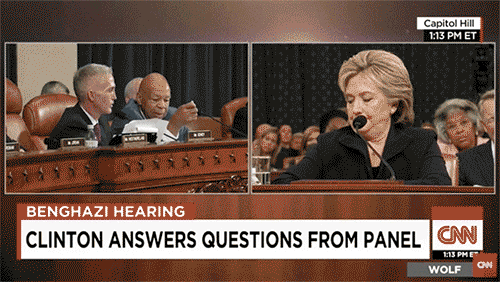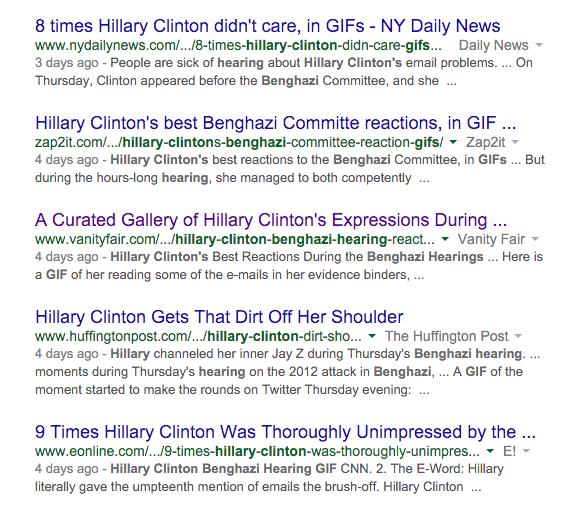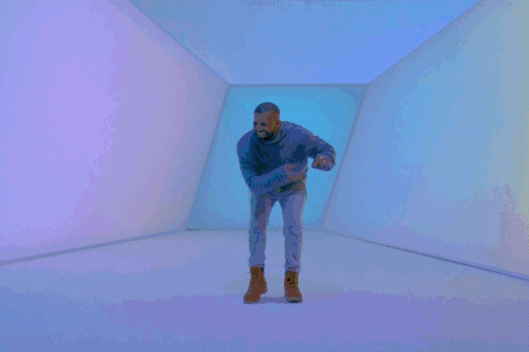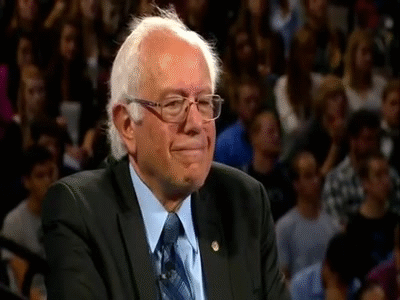Too Long; Couldn’t Tweet: The 2016 Election will be won with GIFs
Twitter is wonderful. In fact, you should follow Random Nerds on there. However, we find the 140 character limit a bit, well, limiting sometimes when it comes to our ‘Cool thought, but there isn’t a whole article here’ ideas.
Too Long; Couldn’t Tweet is where we share those 141+ character thoughts stuck in limbo between tweet and post.
Unless you’re a masochist and/or political junkie, there’s a good chance that even though Hillary Clinton was questioned for an unfathomable 11 hours during the 8th(!) Benghazi hearing, you didn’t watch a single minute of it.
However, if you frequented the internet in the days afterwards, odds are you caught this second-long recap of the proceedings:

And if a picture says a thousand words, this GIF speaks volumes.
Now you, the well-intentioned, semi-informed layperson don’t have to have read the thousands upon thousands of words strewn across the infinite number of op-eds about the attack on a US Embassy, the overkill of witch-hunt hearings, and what this all means for Hillary’s campaign. Instead, thanks to one, repetitive image, the entire mood of the affair has been captured for you to quickly digest.
And if today’s news outlets love anything, it’s turning complex issues into endearingly simplistic angles:

To be honest, it’s a freaking brilliant strategy by Hillary and her team.
Candidates and pundits danced around the concept of the all-powerful GIF last election cycle — as PBS’ Idea Channel so eloquently pointed out four years ago # — but back in 2012, GIFs were still seen as a niche bit of internet subculture. Now, in 2015, they’re an inescapable part of our daily digital lexicon. MIT Students are trying to scientifically qualify them as their own language, and the COO of Giphy, Adam Leibsohn, even claimed that GIFs are our linguistic future:
We’re going to communicate through our content. We’re not going to communicate through words anymore, especially when its efficient, effective, mobile and goes on social really well.
To put it in an historical perspective, the famous Lincoln-Douglas debates that took place back in 1858# were covered by all the country’s major newspapers, who sent stenographers to transcribe every single word the two said, and those who wished to follow along with the series of seven debates were given complete texts of the debate to consume. But who in 2015 wants to read anything, let alone a three-hour long debate transcript? We’ve lost the attention span for that kind of thing. In 2015, we want Harry Potter-esque moving pictures that have, at most, two sentences of text. We can wrap our heads around that kind of thing.
And more importantly, we can share that kind of thing.
I mean, just ask Drake and his viral “Hotline Bling” music video about the power of GIF-based marketing:

The GIF has become the lowest common denominator of communication, which therefore makes it the most effective when trying to reach a mass audience.
As Mike Rugnetta pointed out back in 2012:
A GIF is more complete than quotes on paper because the words are reunited with the actions and attitudes of the person who spoke them. It’s more context than no context, and it’s infinitely re-watchable in comparison to video.
And elections have always been vulnerable to the whims of technological change. When Kennedy and Nixon faced off on national television for the first general election presidential debate, it was the candidate that was able to harness the power of the medium that won:
Nixon, pale and underweight from a recent hospitalization, appeared sickly and sweaty, while Kennedy appeared calm and confident. As the story goes, those who listened to the debate on the radio thought Nixon had won. But those listeners were in the minority. By 1960, 88% of American households had televisions — up from just 11% the decade before… Those that watched the debate on TV thought Kennedy was the clear winner. Many say Kennedy won the election that night.
As historian J.N. Druckman explained, “Television primes its audience to rely more on their perceptions of candidate image.” And if you disagree, just ask Jimmy Carter, who got blown off stage by former Hollywood actor Ronald Reagan during the 1980 debate. All it took was a few great one-liners from Reagan, who looked much more natural behind the podium, and Carter was done for.
Clinton may have shot for the moon when she tried to relate to voters via emojis, but with a strong, targeted presence on niche social networks like Instagram, Pinterest, Snapchat, and Spotify, it’s apparent that she and her team know the war for votes will take place on new and uncommon battlefields.
Now let’s just see if Bernie Sanders is ready to meet her there.

Submitted To The 2016 Election, Too Long; Couldn't Tweet
Like what you read? Share it.
(That helps us.)
Love what you read? Patronize Bryce Rudow.
That helps us and the writer.
What is Patronizing? Learn more here.

